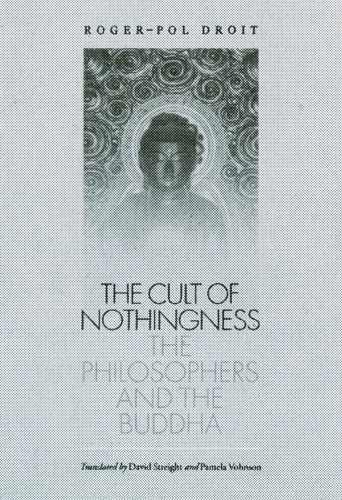 The Cult of Nothingness:
The Cult of Nothingness:
The Philosophers and the Buddha
Roger-Pol Droit
Translated by David Streight and Pamela Vohnson
Chapel Hill: University of North Carolina Press, 2003
288 pp.; $59.95 (cloth), $24.95 (paper)
What do people think about when they think about Buddhism? Maybe it’s the Dalai Lama, beaming amid a clutch of eager young monks or smiling benevolently at a throng of Hollywood admirers. Maybe it’s a bald, bespectacled, and black-robed woman from lower Manhattan, presiding over the neighborhood zendo. Or maybe it’s Keanu Reeves, in a flattering dhoti and heavy eyeliner, sitting unperturbed beneath the Bodhi tree amid a blizzard of special effects.
While the images that Buddhism evokes these days are varied and eclectic, they are also, for the most part, benign, if not downright boosterish. Even Madison Avenue has assumed that position, serving up lotus-posed business executives as a modern beau ideal—clear-eyed, compassionate, efficient, and wise. But as The Cult of Nothingness makes abundantly clear, this wasn’t always the case—especially not on the Continent in the early years of the nineteenth century, when avid “Orientalists” versed in Sanskrit and Pali were beginning to decipher sacred texts that talked of suffering and emptiness and a maddeningly unfathomable state called nirvana.
“In the beginning, the existence of Buddhism, a quite late discovery, was like a bad dream for Europe,” writes Roger-Pol Droit, a philosopher at the Centre National de la Recherche Scientifique in Paris. “It was seen as a paradoxical and horrible religion of nothingness. . . . The fright raised by the Buddha in the minds of some philosophers was not unlike what happens with specters.” The philosophers Droit has foremost in his own mind are Hegel, Schopenhauer, Nietzsche, and Victor Cousin, whose pronouncements on the subject did indeed have many scholars brandishing verbal pikes and pitchforks.
Consider the opinion of Jules Barthélemy Saint-Hilaire, a prominent politician and academic, who was a fervent disciple of Cousin. “More than any other author,” Droit notes, “he piled on the disparaging epithets. . . . The Buddha’s teachings are ‘deplorable and absurd,’ his system is ‘hideous,’ founded on ‘sad principles,’ stuffed with ‘monstrous errors,’ full of ‘gloomy meaning’ and leading to a ‘moral suicide.’ In short, it was the ‘most revolting of religions.’”
As Droit explains, such panic and disgust often arose from understandable misreading of the evidence at hand. Many of the concepts in the translated texts were subtle and strange, and because these ideas had no real parallel in the Western scheme of things, the newly minted commentaries relied on analogy and approximation. But there was also, Droit argues, a willful reinterpretation of the source material in some quarters, with the aim of bolstering a given philosophical or religious agenda.
Originally published in French in 1997 (and here deftly rendered into English by David Streight and Pamela Vohnson), Droit’s book entertainingly traces the evolution of these misunderstandings and the charged emotions they sparked. Covering the eight decades that preceded the 1893 Parliament of Religions in Chicago, it shows the Buddha transformed from a primitive idol (an Indian version of the god Mercury) into a Christ figure, an Ethiopian sage (an assumption based on the statuary treatment of the Buddha’s curly hair), an anti-Brahman rabble-rouser, a moral philosopher (albeit a satanic and nihilistic one), and finally, a model of calm and compassion. When Droit observes that the Buddha “was represented in an exemplary manner, for Hegel, by the ‘pensive attitude’ in which ‘the feet and arms are placed upon one another in such a way that one toe enters the mouth,’” there’s a sense that many of the thinkers cited here have been caught in a similarly awkward posture.
Droit’s project, however, is as much political as it is historical, for he views the fearful representations as symptomatic of anxieties much closer to home. As Europe grappled with profound shifts in its own power structures and upheaval among its social classes, it projected onto the teachings of the Buddha a menacing vision of weakness, cultural decline, godlessness, and annihilation. Moreover, Droit sees in all of this something eerily prescient: “I actually had the feeling that, under the pretext of speaking about the Buddha, these texts were not only talking about the Western world of their time, about a nineteenth-century upset by disturbances of all kinds, but that they were also talking about our time, about the twentieth century and its ‘worship of nothingness,’ about its unprecedented wars and massacres, about its negation of all that is human, about its destructive nihilism.”
Surprisingly, this dire conclusion displays the same pessimism and fatalism that Droit dissects so skillfully elsewhere. And current events notwithstanding, the sentiment is debatable. It’s one thing to see “the cult of nothingness” as “a hidden laboratory for the theoretical development of European nihilism.” It’s quite another to see it as prophecy. Nevertheless, alongside the fascinating reconstruction of Europe’s early encounters with the dharma, there’s a larger—and largely unspoken—lesson here, one that arises from what Schopenhauer called the “insurmountable limit to our speech.” To practice Buddhism is to find the truth of what the Buddha taught. To talk about Buddhism is, almost inevitably, to get lost in translation.
Thank you for subscribing to Tricycle! As a nonprofit, we depend on readers like you to keep Buddhist teachings and practices widely available.